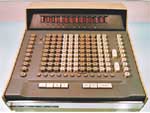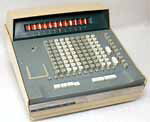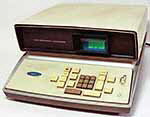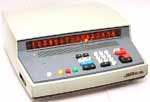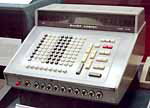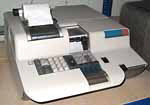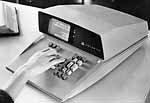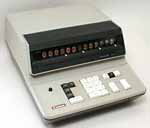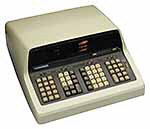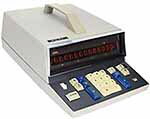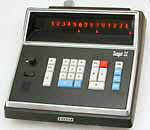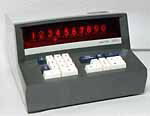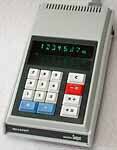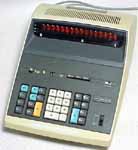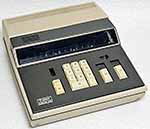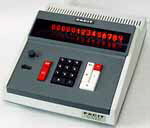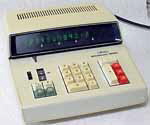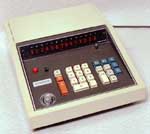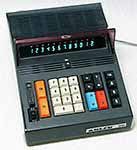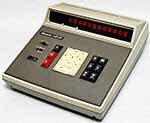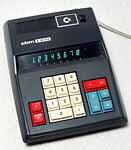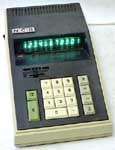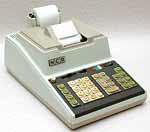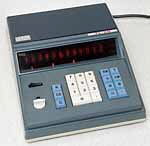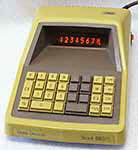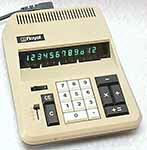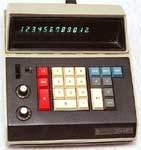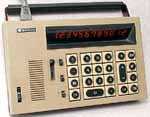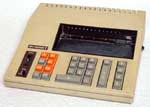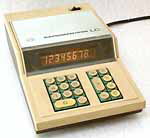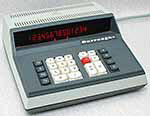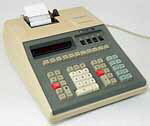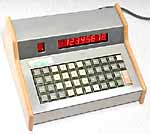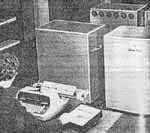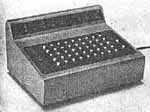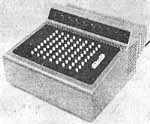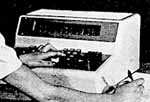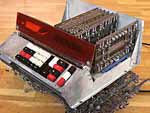Home > Desk Electronic Calculators
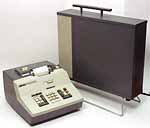
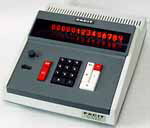

Featured Electronic Desktop Calculators:
The first electronic desktop calculators were the ANITA Mk VII and Mk 8 which employ vacuum tube technology and were introduced simultanueously in late 1961.
Desktop calculators using Germanium transistors appeared in late 1963/early 1964 with the Friden EC-130, IME 84RC, Sharp Compet CS-10A, and the Mathatron.
In the mid-1960s the first calculators using integrated circuits appeared, initially using many small-scale integrated circuits. Electronic calculators were at the forefront of integrated circuit development, and gradually more of the circuitry was squeezed into fewer integrated circuits, also reducing the size of the calculator. This culminated in the first use of a "calculator on a chip" in the Busicom Junior / NCR 18-16 in 1969.
Featured here are significant desktop calculators and a selection of typical models.
For photographs and brief details of some other desktop electronic calculators see the Desktop Calculator Photo Library on this site.
See also "Precursors and Prototypes" at the bottom of this page, which includes some especially interesting early electronic calculators which never went into production.
For information about the electronics inside the calculators see the Calculator Technology section.
Click on a picture below for more details and more, bigger pictures.
The first electronic desktop calculators
... based on vacuum tube technology.
ANITA Mk VII
1961
The Anita Mk VII and Mk 8 were the first electronic desktop calculators.
Four-function, with full-keyboard.
Uses cold-cathode tubes & vacuum tubes (thermionic valves).
ANITA Mk 8
1961
The Anita Mk VII and Mk 8 were the first electronic desktop calculators.
Four-function, with full-keyboard.
Uses cold-cathode tubes & vacuum tubes (thermionic valves).
Some of the first all-transistor electronic desktop calculators
Friden EC-130 & EC-132
1964
EC130 was one of the
first all-transistor desktop calculators.
Four-function, square root.
Uses Germanium transistors, delay-line memory, cathode ray tube display.
IME 84
1964
Was one of the first all-transistor desktop calculators.
Four-function, raising to powers.
Uses Germanium transistors & magnetic core memory.
Sharp Compet CS10A
1964
Was one of the first all-transistor desktop
calculators.
Four-function, with full-keyboard.
Uses discrete transistors.
The first two programmable desktop calculators
Mathatron
1964
Was one of the first
all-transistor desktop calculators. Was programmable
Four-function, square root.
Uses discrete transistors.
Olivetti programma 101
1965
Was the first stored-program desktop calculator, or was
it the first desktop computer?
Four-function, square root, branching instruction.
Uses discrete transistors.
The first desktop calculator using integrated circuits
Victor 3900
1965
The first desktop calculator using integrated circuits.
cathode
ray tube display.
Uses integrated circuits - Problems manufacturing the integrated circuits meant that very few were sold.
A selection of other all-transistor electronic desktop calculators
Casio AL-1000
1967
Four-function, memory, square
root, programmable.
Uses Germanium transistors & magnetic core memory.
IME 26
1967
Four-function.
Uses Germanium transistors
& magnetic core memory.
Monroe Epic 3000
1967
Four-function,
programmable, with printout.
Uses Germanium transistors & delay-line memories.
Canon Canola 130S
1968
Four-function.
Uses
Germanium transistors & "light-pipe" display.
Hewlett-Packard HP-9100A
1968
Scientific programmable.
Uses discrete transistors and magnetic core memory.
Sony SOBAX 400W
1969
Four-function,
memory.
Uses hybrid integrated circuits and delay-line memory.
Featured electronic desktop calculators, using silicon integrated circuits
... in approximate chronological order
Sharp Compet 22
1968
Four-function, memory.
Could be made programmable by plugging in a "memorizer" unit.
Uses Small-Scale Integration (SSI) integrated circuits.
Anita 1011
1969
Four-function, %, memory.
Uses
Medium-Scale Integration (MSI) integrated circuits & transistors.
Sharp QT-8D "micro Compet"
1969
Four-function.
The first calculator to use Large-Scale Integration (LSI) integrated circuits.
The first calculator to use a VFD (Vacuum Fluorescent Display).
Is much smaller than any other electronic
calculator at this time.
Uses a four-chip chipset manufactured by Rockwell.
Toshiba BC1623G
1969
Programmable, 2 memories,
square root.
Uses Medium-Scale Integration (MSI) integrated circuits.
Canon Canola 1200
~1970
Four-function.
Uses
Medium-Scale Integration (MSI) integrated circuits.
Facit 1123
~1970
Four-function.
Uses Small-Scale
Integration (SSI) integrated circuits.
Ricoh RICOMAC 1200
~1970
Four-function.
Uses a six-chip chipset manufactured by American Micro-systems Inc. (AMI) and Medium-Scale Integration (MSI) integrated circuits.
Singer Friden EC1114
~1970
Four-function,
memory.
Uses Medium-Scale Integration (MSI) integrated circuits.
Adler 1210
~1971
Four-function, memory.
Uses
Medium-Scale Integration (MSI) integrated circuits.
ANITA 1011 LSI
~1971
Four-function,
memory.
Uses a five-chip chipset manufactured by General Instrument Microelectronics (GIM).
Casio 121K
~1971
Four-function.
Uses a four-chip
chipset manufactured by Fairchild Semiconductor and Small-Scale Integration (SSI) integrated circuits.
Casio AS-C
~1971
Four-function.
Uses a four-chip
chipset manufactured by Fairchild Semiconductor and Small-Scale Integration (SSI) integrated circuits.
Commodore (cbm) C108 and Adler 804
~1971
Four-function.
Uses a three-chip chipset designed by Omron and manufactured by Nortec Electronics.
A small, low-cost calculator.
NCR 18-16 (aka Busicom Junior)
~1971
Four-function.
Uses a single integrated circuit manufactured by Mostek.
First use of a "Calculator-on-a-Chip" - All calculator functions in a single Large-Scale Integration (LSI)
integrated circuit
Busicom 141-PF / NCR 18-36
1971
Four-function, memory, printout.
Uses an Intel 4004 microprocessor system.
The microprocessor was developed for this calculator. Has an Intel 4004 microprocessor - the first product to have "Intel
Inside".
Olympia CD200
~1971
Four-function.
Uses a
five-chip chipset manufactured by Solitron Devices.
Probably the ugliest calculator ever made.
Singer Friden EC1117
~1971
Four-function.
Uses
a nine-chip chipset manufactured by Hitachi.
TEAL TL-2M
~1971
Four-function, memory.
Uses a
six-chip chipset manufactured by Mitsubishi.
Made by Tokyo Electronic Application Laboratory Ltd., a casualty of the crash in calculator prices.
Data Devices Brock 880/1
~1972
Four-function, square root, square, memory.
Uses a six-chip chipset from Electroinc Arrays.
Has a first-generation 'Pandicon' display.
Royal IC-130
~1972
Four-function.
Uses a chip
manufactured by Fairchild Semiconductor, another chip from NEC, and Small-Scale Integration (SSI) integrated circuits.
Hitachi KK521
~1972
Four-function, memory.
Uses
a three-chip chipset manufactured by Hitachi.
Sanyo ICC-1122
~1972
"Portable radio"-shaped
case.
Four-function, memory.
Uses a two-chip chipset manufactured by Sanyo.
Summit 3114
~1972
Four-function, memory.
Uses
three-chip chip set from Integrated Systems Technology (IST) and Small Scale Integration (SSI) chips.
Advance / Wireless World
1972
Make it yourself calculator
kit.
Four function.
Uses the first Texas Instruments "calculator-on-a-chip".
Rapid Data Rapidman 1208LC, Sears C1, Sears M12
1972
Among
the first desktop models with LCD (Liquid Crystal Display)
Four function, %.
Use four-chip or three-chip chipset manufactured by Rockwell.
Burroughs C5205
~1973
Four function, memory,
Panaplex display.
Uses six chips, four manufactured by American Micro-systems Inc (AMI) and two by Burroughs.
Rockwell 920
~1975
Limited scientific,
programmable, magnetic card reader, printer.
Uses the early Rockwell PPS-4 microprocessor system.
Betting-shop Calculators
~1972 to ~1982
Some
specialised calculators for use in settling bets in betting-shops.
Several use microprocessor & PROM (Progreammable Read-Only Memory) system.
Some precursors to the electronic desktop calculator and some prototypes which never went into production.
Electronic Accounting Machines
Bandatronic
1960
Electronic accounting machine for invoices
with arithmetic unit and up to five typewriters.
Some prototype electronic calculators that never went into production
Electrosolids Corp. Electronic Calculator - Computron CC 1200
1961
Transistorised electronic calculator announced.
Durham University Electronic Calculator
1962
Hybrid Dekatron/Trigger-tube/Transistor electronic calculator "proof-of-concept" exhibited.
Philips Prototype Electronic Calculators
1962
A prototype 3-function electronic calculator and two models of electronic "Comptometer", which never went into production.
A step on the way to the first commercial transistorised eletronic desktop calculators.
Mullard Prototype Electronic Calculator
1964
Early, low-cost, electronic calculator, never went into production.
Cold-cathode tubes and transistors.
Ultramat SQR-2000
1966
Early, prototype,
electronic calculator produced by high-school student.
Transistors.
The first electronic desk calculators of the 1960s and early 1970s were very large and VERY expensive, but were versatile, quick, and silent.
They were so expensive that many could be rented by the week.
If you only wanted to
add lists of numbers then mechanical and electro-mechanical calculators were fast and still cost effective into the early 1970s, until the price of the electronic ones plummeted.
There was a general reduction in size, number of electronic components, and cost over this period. For further information see the section on The Calculator Business and the section on Calculator Electronics.
This is only a small sample of vintage electronic desktop calculators. There were many more models from many manufacturers.
Other notable early manufacturers were -
- WYLE LABORATORIES - Very early transistorised scientific calculators - See https://www.trailingedge-technology.com/ and https://www.oldcalculatormuseum.com/d-compucorp.html
- Olympia
For featured British desktop electronic calculators see the associated British Vintage Calculators site.
There are photographs and brief details of other desktop electronic calculators on this site in the Desktop Electronic Calculator Photographic Library.
For general information about the electronics of calculators see the Calculator Technology section.
An excellent source of information about vintage electronic desk calculators is Rick Bensene's "Old Calulator Web Museum" site http://www.oldcalculatormuseum.com/.
Vintage Calculators
Text & photographs copyright, except where stated otherwise, © Nigel Tout 2000-2025.
